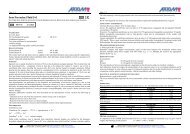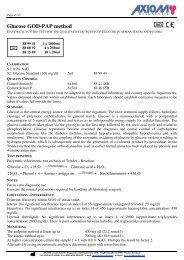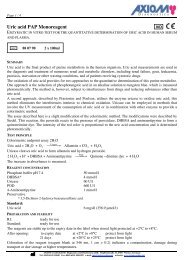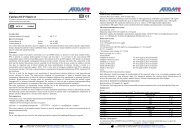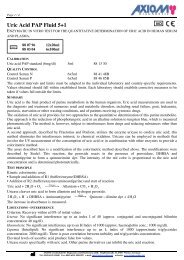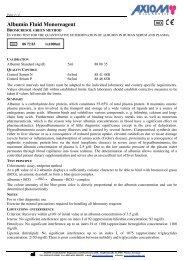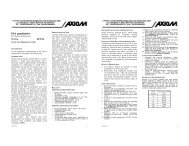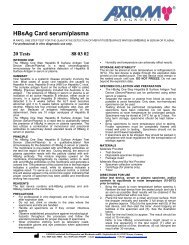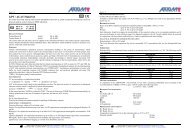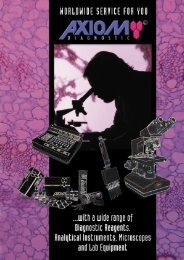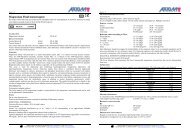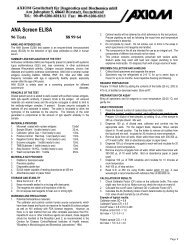GOT ASAT 88 58 99 - AXIOM Solutions
GOT ASAT 88 58 99 - AXIOM Solutions
GOT ASAT 88 58 99 - AXIOM Solutions
Create successful ePaper yourself
Turn your PDF publications into a flip-book with our unique Google optimized e-Paper software.
!!Page 1 / 4<strong>GOT</strong>/<strong>ASAT</strong> Fluid 5+1<strong>88</strong> <strong>58</strong> <strong>99</strong> 12 x 20ml<strong>88</strong> 28 62 6 x 100mlD I A G N O S T I CIN VITRO TEST FOR THE QUANTITATIVE DETERMINATION OF ASPARTATE AMINO-TRANSFERASE (AST)IN HUMAN SERUM AND PLASMA BY IFCC- METHODE.REFREFQUALITY CONTROLControl Serum N 6x5ml <strong>88</strong> 41 48BControl Serum P 6x5ml <strong>88</strong> 46 85BThe control intervals and limits must be adapted to the individual laboratory and country-specific requirements.Values obtained should fall within established limits. Each laboratory should establish corrective measures to betaken if values fall outside the limits.SUMMARYAspartate aminotransferase (glutamate oxaloacetate transaminase) belongs to the transaminases, which catalyzethe interconversion of amino acids and !-ketoacids by transfer of amino groups. Aspartate aminotransferase iscommonly found in human tissue. Although heart muscle is found to have the most activity of the enzyme,significant activity has also been seen in the brain, liver, gastric mucosa, adipose tissue, skeletal muscle, andkidneys.AST is present in both the cytoplasm and mitochondria of cells. In cases involving mild tissue injury, thepredominant form of AST is that from the cytoplasm, with a smaller amount coming from the mitochondria.Severe tissue damage results in more of the mitochondrial enzyme being released. Elevated levels of thetransaminases can signal myocardial infarction, hepatic disease, muscular dystrophy, and organ damage.In 1955, Karmen et al described the first kinetic determination of AST activity in serum. The InternationalFederation of Clinical Chemistry (IFCC) recommended in 1977 and 1980 standardized procedures for ASTdetermination, including optimization of substrate concentrations, employment of TRIS* buffers, preincubation ofcombined buffer and serum to allow side reactions with NADH to occur, substrate start, and optional pyridoxalphosphate activation. This method is derived from the IFCC reterence method.*TRIS = Tris(hydroxymethyl)-aminomethaneTEST PRINCIPLEUV test according to a standardized methodAST2 - oxoglutarate + L - aspartate " "#L - glutamate + oxolacetateAST is the enzyme which catalyzes this equilibrium reaction. The oxalacetate increase is measured in asubsequent indicator reaction which is catalyzed by malate dehydrogenase.oxoacetate + NADH + H + " MDH "#L - malate + NAD +In the second reaction, NADH is oxidized to NAD. The rate of decrease in NADH (Measured photometrically) isdirectly proportional to the rate of formation of oxalacetate, and thus the AST activity.NOTESFor in vitro diagnostic use.Exercise the normal precautions required for handling all laboratory reagents.LIMITATIONS - INTERFERENCECriterion: Recovery within ±10% of initial value.Hemolysis interferes due to AST activity from erythrocytes.Icterus: No significant interference up to an index I of 20 (approximate conjugated and unconjugated bilirubin: 20mg/dl)Hemolysis: No significant interference up to an index H of 1100 (approximate haemoglobin concentration: 1100mg/dl).IVDPage 2 / 4D I A G N O S T I CLipemia (Intralipid): No significant interference up to an index L of 325 (approximate triglycerides concentration:650 mg/dl).Lipemia may cause absorbance flagging as a result of an absorbance increase.MEASURING/REPORTABLE RANGE0.160 at 340 nm or 0.080 at 365 nmAt higher activities dilute the sample with 0.9% NaCl (e.g. 1+3). Multiply the result by the appropriate dilutionfactor (e.g. 4)Roche/Hitachi: 800 U/I or 13.34 µkat/lDetermine samples with higher activities via the rerun function. On instruments without rerun function, manuallydilute the samples with 0.9% NaCI or distilled/deionized water (e.g. 1 + 3). Multiply the result by the appropriatedilution factor (e.g. factor 4)REFERENCE VALUESAccording to the IFCC method at +37°C:Menup to 38 U/l or up to 0.63 µkat/lWomenup to 32 U/l or up to 0.53 µkat/lEach laboratory should investigate the transferability of the expected values to its own patient population and ifnecessary determine its own reference range. For diagnostic purposes, the AST results should always be assessedin conjunction with the patients medical history, clinical examination and other findings.ANALYTICAL SENSITIVITY (LOWER DETECTION LIMIT)Detection limit: 4 U/l or 0.07 µkat/lThe lower detection limit represents the lowest measurable AST concentration that can be distinguished fromzero.IMPRECISIONReproducibility was determined using controls in an internal protocol between day (n = 20). The following resultswere obtained:Between daySample Mean U/l SD U/l CV %Sample 1 43.5 2.05 4.71Sample 2 83.4 1.95 2.34Sample 3 127 2.92 2.30Reproducibility was determined using controls within protocol between run (n = 20). The following results wereobtained:Within runSample Mean U/l SD U/l CV %Sample 1 39.8 1.13 2.83Sample 2 86.0 1.04 1.21Sample 3 135 1.51 1.12METHOD COMPARISONA comparison of the <strong>AXIOM</strong> <strong>GOT</strong>/<strong>ASAT</strong> Fluid 5+1 (y) with a commercial obtainable assay (x) gave thefollowing result with <strong>58</strong> samples: y = 0.946 x + 1.385; r= 0.<strong>99</strong>8REAGENT CONCENTRATION:R1:Tris buffer pH 7.8L-AspartateLDHMDHR2:NADH 22-Oxoglutarate100 mmol/l200 mmol/l800 U/l600 U/l0.18 mmol/l12 mmol/l<strong>AXIOM</strong> Gesellschaft für Diagnostica und Biochemica mbH; Siegfriedstraße 14, 67547 Worms, GermanyTel.: 0049-6241-50040 Fax: 0049-6241-50044<strong>99</strong> e-mail: info@axiom-online.net webseite: www.axiom-online.net<strong>AXIOM</strong> Gesellschaft für Diagnostica und Biochemica mbH; Siegfriedstraße 14, 67547 Worms, GermanyTel.: 0049-6241-50040 Fax: 0049-6241-50044<strong>99</strong> e-mail: info@axiom-online.net webseite: www.axiom-online.net
Page 3 / 4D I A G N O S T I CPage 4 / 4D I A G N O S T I CPREPARATION AND STABILITYR1: Ready for use.R2: Ready for use.Unopened kit components:Up to the expiration date at +2°C to +8°COnboard stability: R1 28 daysR290 daysSPECIMENCollect serum using standard sampling tubes.Heparinized or EDTA plasma. Do not use citrate, oxalate or fluoride.Stability: 24 days at +20°C to +25°C3daysat +2°C to +8°CFasting and nonfasting samples can be used.Centrifuge samples containing precipitate before performing assay.TESTING PROCEDUREMaterials provided• Working solutions as described aboveAdditional materials required• Controls as indicated below• 0.9% NaClManual procedure serum start:WavelengthHg 334 nm, 340 nm or Hg 365 nmTemperature+25°C / +30°C / +37°CCuvette1cm light pathZero adjustmentagainst airMix R1 and R2 5+1. This solution is stable: up to 10 days at +2°C to +8°C orup to 1 day at +20°C to +25°CReagent mixture 1000 µlSerum / plasma 100 µlMix and incubate 60 seconds at assay temperature and start stopwatch simultaneously. Read again after exactly1, 2 and 3 minutes.Calculation:Hg 365 nmHg 340 nmHg 334 nm3235 x !A/min1746 x !A/min1780 x !A/minManual procedure substrat start:WavelengthHg 334 nm, 340 nm or Hg 365 nmTemperature+25°C / +30°C / +37°CCuvette1cm light pathZero adjustmentagainst airR 1 1000 µlSerum / plasma 100 µlMix and incubate 60 seconds at assay temperature then addR2 200 µlMix, read initial absorbance and start stopwatch simultaneously. Repeat reading after exactly 1, 2 and 3 min.Calculation:Hg 365 nmHg 340 nmHg 334 nm3823 x !A/min2063 x !A/min2103 x !A/min<strong>AXIOM</strong> Gesellschaft für Diagnostica und Biochemica mbH; Siegfriedstraße 14, 67547 Worms, GermanyTel.: 0049-6241-50040 Fax: 0049-6241-50044<strong>99</strong> e-mail: info@axiom-online.net webseite: www.axiom-online.netDISPOSALPlease note the legal regulations.LITERATURE1. Bablok W et al. A General Regression Procedure for Method Transformation. J Clin Chem Clin Biochem 19<strong>88</strong>;26:783-790.2. Bergmeyer HU, Herder M, Rej R. Approved recommendation (1985) on IFCC methods for the measurement of catalyticconcentration of enzymes. Part 2. IFCC Method for aspartate aminotransferase. J Clin Chem Clin Biochem 1986;24:49.3. Glick MR, Ryder KW, Jackson SA. Graphical Comparisons of Interferences in Clinical Chemistry Instrumentation.Clin Chem 1 986;32:470-474.4. Greiling H, Gressner AM (Hrsg.). Lehrbuch der Klinischen Chemie und Pathobiochemie,3. Auflage. Stuttgart/New York: Schattauer Verlag, 1<strong>99</strong>55. Karmen A et al. J Clin Invest 1955;24:126.6. Schmidt FW. Ref Med Ges, Marburg/Lahn, December 1959.7. Passing H, Bablok W. A New Biometrical Procedure for Testing the Equality of Measurements from Two Different AnalyticalMethods. J Clin Chem Clin Biochem 1983;21:709-720.8. Thefeld W et al. Dtsch med Wschr 1974;<strong>99</strong>:343.9. Tietz NW (Hrsg.). Clinical Guide to Laboratory Tests, 3. Auflage. Philadelphia, PA: WB Saunders, 1<strong>99</strong>5:76-77. Wallnöfer H,Schmidt E, Schmidt FW (Hrsg.). Synopsis der Leberkrankheiten. Stuttgart: Georg Thieme Verlag, 1974.<strong>AXIOM</strong> Product range Clinical ChemistryEnzymes Ions Other MetabolitesAcid Phosphatase Ammonium fluid Bilirubin T/DAlkaline Phosphatase Copper fluid Creatinine fluid!-Amylase direct Calcium fluid Glucose GOD-PAP fluidCK-NAC actived Chloride fluid Glucose Hexokinase fluidCK-MB (NAC- actived) Inorganic Phosphorus UV fluid Urea Enzymatic fluid"-GT fluid Iron fluid Urea UV fluidLDH fluid TIBC Uric Acid PAP fluidCholinesteraseMagnesium fluid<strong>GOT</strong>/<strong>ASAT</strong> fluidPotassium fluidGPT/ALAT fluidSodium fluidControlsLipase UV fluidControl Serum NLactate PAPControl Serum PProteins!-HBDHLipidsAlbuminCSF-Protein fluidCholesterol fluidMicroprotein fluidHDL CholesterolHemoglobinLDL CholesterolProtein Total fluidTriglycerides fluid<strong>AXIOM</strong> Gesellschaft für Diagnostica und Biochemica mbH; Siegfriedstraße 14, 67547 Worms, GermanyTel.: 0049-6241-50040 Fax: 0049-6241-50044<strong>99</strong> e-mail: info@axiom-online.net webseite: www.axiom-online.net06/09 M/kd



